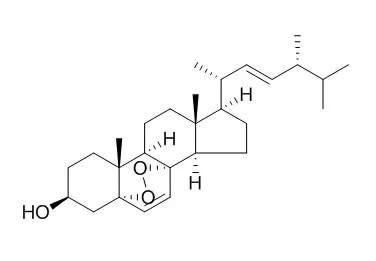| Phytother Res. 2012 Jun;26(6):938-43. |
| Trypanocidal activity of ergosterol peroxide from Pleurotus ostreatus.[Pubmed: 22083593] |
Chagas' disease, which is caused by the protozoan parasite Trypanosoma cruzi, is a public health problem in South America affecting millions of people, and more recently several thousands in countries where the disease is not endemic. Due to the magnitude of the problem, finding a cure for this disease remains a major challenge.
METHODS AND RESULTS:
The aim of this study is to evaluate the trypanocidal activity of Ergosterol peroxide (5α, 8α-epidioxy-22E-ergosta-6, 22-dien-3β-ol) isolated from Pleurotus ostreatus (Jacq.) P. Kumm. f. sp. Florida. The Ergosterol peroxide showed strong trypanocidal activity on the intracellular form of T. cruzi. Ergosterol peroxide had an inhibitory concentration (IC₅₀) of 6.74 µg/mL on T. cruzi, but showed no lytic action on erythrocytes and no cytotoxic effect on mammalian cells at concentrations higher than 1600 µg/mL. The interaction of Trypanosoma cruzi with Ergosterol peroxide in vitro resulted in a strong lytic activity possibly due to the disruption of the parasite membrane.
CONCLUSIONS:
This is the first report of trypanocidal activity, a new biological property of Ergosterol peroxide isolated from Pleurotus ostreatus (Jacq.) P. Kumm. f. sp. Florida. |
| PLoS One. 2012;7(8):e44579. |
| Ergosterol peroxide isolated from Ganoderma lucidum abolishes microRNA miR-378-mediated tumor cells on chemoresistance.[Pubmed: 22952996] |
Due to an altered expression of oncogenic factors and tumor suppressors, aggressive cancer cells have an intrinsic or acquired resistance to chemotherapeutic agents. This typically contributes to cancer recurrence after chemotherapy. microRNAs are short non-coding RNAs that are involved in both cell self-renewal and cancer development.
METHODS AND RESULTS:
Here we report that tumor cells transfected with miR-378 acquired properties of aggressive cancer cells. Overexpression of miR-378 enhanced both cell survival and colony formation, and contributed to multiple drug resistance. Higher concentrations of chemotherapeutic drugs were needed to induce death of miR-378-transfected cells than to induce death of control cells. We found that the biologically active component isolated from Ganoderma lucidum could overcome the drug-resistance conferred by miR-378. We purified and identified the biologically active component of Ganoderma lucidum as Ergosterol peroxide.
CONCLUSIONS:
We demonstrated that Ergosterol peroxide produced greater activity in inducing death of miR-378 cells than the GFP cells. Lower concentrations of Ergosterol peroxide were needed to induce death of the miR-378-transfected cells than in the control cells. With further clinical development, Ergosterol peroxide represents a promising new reagent that can overcome the drug-resistance of tumor cells. |
| Bmc Cancer, 2012, 12(1):1-11. |
| Inhibition of STAT3 signaling and induction of SHP1 mediate antiangiogenic and antitumor activities of ergosterol peroxide in U266 multiple myeloma cells[Pubmed: 22260501] |
Ergosterol peroxide (EP) derived from edible mushroom has been shown to exert anti-tumor activity in several cancer cells. In the present study, anti-angiogenic activity of EP was investigated with the underlying molecular mechanisms in human multiple myeloma U266 cells.
METHODS AND RESULTS:
Despite weak cytotoxicity against U266 cells, EP suppressed phosphorylation, DNA binding activity and nuclear translocalization of signal transducer and activator of transcription 3 (STAT3) in U266 cells at nontoxic concentrations. Also, EP inhibited phosphorylation of the upstream kinases Janus kinase 2 (JAK2) and Src in a time-dependent manner. Furthermore, EP increased the expression of protein tyrosine phosphatase SHP-1 at protein and mRNA levels, and conversely silencing of the SHP-1 gene clearly blocked EP-mediated STAT3 inactivation. In addition, EP significantly decreased vascular endothelial growth factor (VEGF), one of STAT3 target genes at cellular and protein levels as well as disrupted in vitro tube formation assay. Moreover, EP significantly suppressed the growth of U266 cells inoculated in female BALB/c athymic nude mice and immunohistochemistry revealed that EP effectively reduced the expression of STAT3 and CD34 in tumor sections compared to untreated control.
CONCLUSIONS:
These findings suggest that EP can exert antitumor activity in multiple myeloma U266 cells partly with antiangiogenic activity targeting JAK2/STAT3 signaling pathway as a potent cancer preventive agent for treatment of multiple myeloma cells. |
| Pharmazie, 1989, 44(44):579-80. |
| Antiviral activity of ergosterol peroxide.[Reference: WebLink] |
| Antiviral activity of Ergosterol peroxide. |
| 2019 Sep 11;24(18):3307. |
| Synthesis of Ergosterol Peroxide Conjugates as Mitochondria Targeting Probes for Enhanced Anticancer Activity[Pubmed: 31514398] |
| Abstract
Inspired by the significant bioactivity of Ergosterol peroxide, we designed and synthesized four fluorescent coumarin and Ergosterol peroxide conjugates 8a-d through the combination of Ergosterol peroxide with 7-N,N-diethylamino coumarins fluorophore. The cytotoxicity of synthesized conjugates against three human cancer cells (HepG2, SK-Hep1, and MCF-7) was evaluated. The results of fluorescent imaging showed that the synthesized conjugates 8a-d localized and enriched mainly in mitochondria, leading to significantly enhanced cytotoxicity over Ergosterol peroxide. Furthermore, the results of biological functions of 8d showed that it could suppress cell colony formation, invasion, and migration; induce G2/M phase arrest of HepG2 cells, and increase the intracellular ROS level.
Keywords: antitumor activity; Ergosterol peroxide; fluorescence imaging; mitochondria; target probe. |
| 2019 May 29;17(21):5223-5229. |
| Development of ergosterol peroxide probes for cellular localisation studies[Pubmed: 31025693] |
| Abstract
Ergosterol peroxide selectively exhibits biological activity against a wide range of diseases; however, its mode of action remains unknown. Here, we present an efficient synthesis of Ergosterol peroxide chemical probes for in vitro anticancer evaluation, live cell studies and proteomic profiling. Ergosterol peroxide analogues show promising anti-proliferation activity against triple negative breast cancer cellular models, revealing information on the structure-activity relationship of this natural product in order to develop superior analogues. The combined cellular studies demonstrate that Ergosterol peroxide is distributed across the cytosol with significant accumulation in the endoplasmic reticulum (ER). These chemical probes support our efforts towards uncovering the potential target(s) of Ergosterol peroxide against triple negative breast cancer cell lines. |






 Cell. 2018 Jan 11;172(1-2):249-261.e12. doi: 10.1016/j.cell.2017.12.019.IF=36.216(2019)
Cell. 2018 Jan 11;172(1-2):249-261.e12. doi: 10.1016/j.cell.2017.12.019.IF=36.216(2019) Cell Metab. 2020 Mar 3;31(3):534-548.e5. doi: 10.1016/j.cmet.2020.01.002.IF=22.415(2019)
Cell Metab. 2020 Mar 3;31(3):534-548.e5. doi: 10.1016/j.cmet.2020.01.002.IF=22.415(2019) Mol Cell. 2017 Nov 16;68(4):673-685.e6. doi: 10.1016/j.molcel.2017.10.022.IF=14.548(2019)
Mol Cell. 2017 Nov 16;68(4):673-685.e6. doi: 10.1016/j.molcel.2017.10.022.IF=14.548(2019)